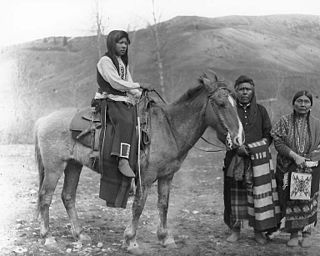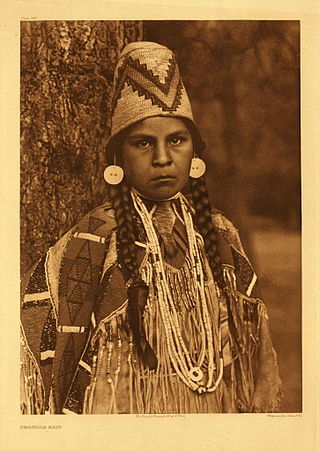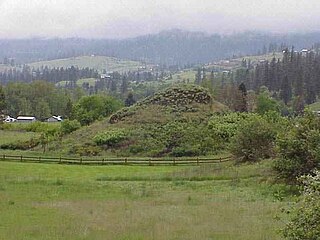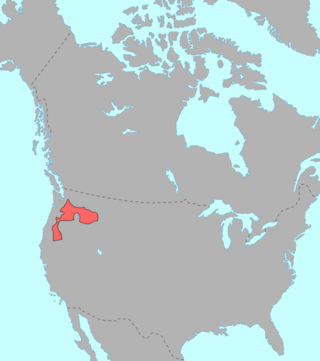
The Nez Perce are an Indigenous people of the Plateau who still live on a fraction of the lands on the southeastern Columbia River Plateau in the Pacific Northwest. This region has been occupied for at least 11,500 years.

The Salishan languages are a family of languages of the Pacific Northwest in North America. They are characterised by agglutinativity and syllabic consonants. For instance the Nuxalk word clhp’xwlhtlhplhhskwts’, meaning "he had had [in his possession] a bunchberry plant", has twelve obstruent consonants in a row with no phonetic or phonemic vowels.

The Cayuse are a Native American tribe in what is now the state of Oregon in the United States. The Cayuse tribe shares a reservation and government in northeastern Oregon with the Umatilla and the Walla Walla tribes as part of the Confederated Tribes of the Umatilla Indian Reservation. The reservation is located near Pendleton, Oregon, at the base of the Blue Mountains.

Penutian is a proposed grouping of language families that includes many Native American languages of western North America, predominantly spoken at one time in British Columbia, Washington, Oregon, and California. The existence of a Penutian stock or phylum has been the subject of debate among specialists. Even the unity of some of its component families has been disputed. Some of the problems in the comparative study of languages within the phylum are the result of their early extinction and limited documentation.

The Palouse are a Sahaptin tribe recognized in the Treaty of 1855 with the United States along with the Yakama. It was negotiated at the 1855 Walla Walla Council. A variant spelling is Palus. Today they are enrolled in the federally recognized Confederated Tribes and Bands of the Yakama Nation and some are also represented by the Colville Confederated Tribes, the Confederated Tribes of the Umatilla Indian Reservation and Nez Perce Tribe.

The Umatilla are a Sahaptin-speaking Native American tribe who traditionally inhabited the Columbia Plateau region of the northwestern United States, along the Umatilla and Columbia rivers.

Indigenous peoples of the Northwest Plateau, also referred to by the phrase Indigenous peoples of the Plateau, and historically called the Plateau Indians are Indigenous peoples of the Interior of British Columbia, Canada, and the non-coastal regions of the Northwestern United States.

Plateau Penutian is a proposed family of languages spoken in northern California, reaching through central-western Oregon to northern Washington and central-northern Idaho.

The Kutenai language, also Kootenai, Kootenay, Ktunaxa, and Ksanka, is the native language of the Kutenai people of Montana and Idaho in the United States and British Columbia in Canada. It is typically considered a language isolate, unrelated to the Salishan family of languages spoken by neighboring tribes on the coast and in the interior Plateau. The Kutenai also use ʔa·qanⱡiⱡⱡitnam, Ktunaxa Sign Language.

Nez Perce, also spelled Nez Percé or called nimipuutímt, is a Sahaptian language related to the several dialects of Sahaptin. Nez Perce comes from the French phrase nez percé, "pierced nose"; however, Nez Perce, who call themselves nimíipuu, meaning "the people", did not pierce their noses. This misnomer may have occurred as a result of confusion on the part of the French, as it was surrounding tribes who did so.
Sahaptin, also called Ichishkiin, is one of the two-language Sahaptian branch of the hypothetical Plateau Penutian family spoken in a section of the northwestern plateau along the Columbia River and its tributaries in southern Washington, northern Oregon, and southwestern Idaho, in the United States; the other language is Nez Perce (Niimi'ipuutímt).
Okanagan, or Colville-Okanagan, or Nsyilxcən, is a Salish language which arose among the Indigenous peoples of the southern Interior Plateau region based primarily in the Okanagan River Basin and the Columbia River Basin in precolonial times in Canada and the United States. Following British, American, and Canadian colonization during the 1800s and the subsequent assimilation of all Salishan tribes, the use of Colville-Okanagan declined drastically.
Klamath, also Klamath–Modoc and historically Lutuamian, is a Native American language spoken around Klamath Lake in what is now southern Oregon and northern California. It is the traditional language of the Klamath and Modoc peoples, each of whom spoke a dialect of the language. By 1998, only one native speaker remained, and by 2003, this last fluent Klamath speaker who was living in Chiloquin, Oregon, was 92 years old. As of 2006 there were no fluent native speakers of either the Klamath or Modoc dialects; however, as of 2019, revitalization efforts are underway with the goal of creating new speakers.
The Sinkiuse-Columbia are a Native American tribe so-called because of their former prominent association with the Columbia River. They belong to the inland division of the Salishan group, with their nearest relatives being the Wenatchis and Methows. The Sinkiuses call themselves .tskowa'xtsEnux, or .skowa'xtsEnEx, or Sinkiuse. They apply the name to other neighboring Interior Salish peoples, potentially originating from a band that once inhabited the Umatilla Valley.
Umatilla is a variety of Southern Sahaptin, part of the Sahaptian subfamily of the Plateau Penutian group. It was spoken during late aboriginal times along the Columbia River and is therefore also called Columbia River Sahaptin. It is currently spoken as a first language by a few dozen elders and some adults in the Umatilla Reservation in Oregon. Some sources say that Umatilla is derived from imatilám-hlama: hlama means 'those living at' or 'people of' and there is an ongoing debate about the meaning of imatilám, but it is said to be an island in the Columbia River. B. Rigsby and N. Rude mention the village of ímatalam that was situated at the mouth of the Umatilla River and where the language was spoken.

Cayuse is an extinct unclassified language once spoken by the Cayuse people of Oregon.
Molala is an extinct language once spoken by the Molala people of Oregon. Currently it is included among the Plateau Penutian language family, with Klamath and Sahaptin being considered the closest related.
Bruce Rigsby was an American-Australian anthropologist specializing in the languages and ethnography of native peoples on both continents. He was professor emeritus at Queensland University, and a member of both the Australian Anthropological Society and the American Anthropological Association.
The Yakima practical alphabet is an orthography used to write Sahaptin languages of the Pacific Northwest of North America.
Periodic tense is a subtype of the grammatical category of tense, which encodes that the event expressed by the verb occurs within a particular period of the day or of the year. Its does not encode a relation to a particular point of reference, unlike deictic tense, the grammatical expression of time reference relative either to the moment of speaking or to another point of reference.










